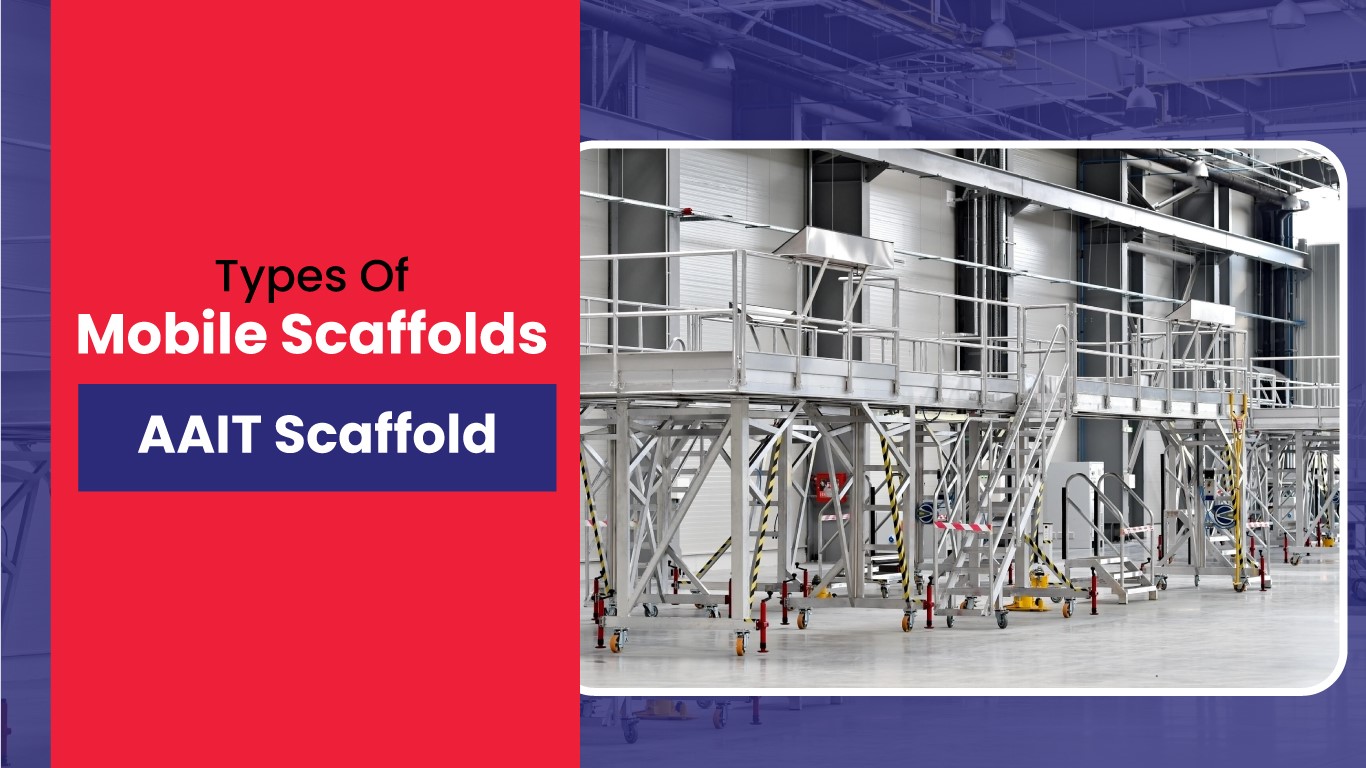
Whenever workers are moving ahead with the construction tasks, they will usually use a scaffold. These serve as a platform for them to execute various tasks at different heights. But, when they have to change positions often across the site, they will use a mobile scaffold. So, in this article we shall cover more about the types of mobile scaffolds.
Why are mobile scaffolds essential?
As teams move ahead with a construction project, mobile scaffolds are crucial. These offer a flexible yet safe platform for people to work at different heights. As these are mounted on wheels, they can be moved around with ease. Hence, workers can quickly access some sections of the structure. They don’t have to worry about building the scaffold once again. Moreover, if such scaffolds are properly maintained, then they can offer support and prevent falls. Now, let’s check the types of mobile scaffolds.
What are the different types of mobile scaffolds?
When you roam around construction sites, you may observe diverse mobile scaffolds.
Folding Mobile Scaffolds
Such types of scaffolds can be folded so that they are easier to carry. Most of the time, these have folding mechanisms for making the scaffold compact. Therefore, workers prefer using these scaffolds when they have to carry them quite often.
Single-Width Scaffolds
This type of scaffold has a platform with just a single width. As 4 wheels support the scaffold, it can be moved in a small space. Thus, professionals use this scaffold for tasks to be carried out within an indoor space.
Double-Width Mobile Scaffolds
Unlike single width scaffolds, double-width scaffolds have a broad platform. Usually, they consist of two single single width platforms and they offer more space. Hence, workers can expect enhanced stability while working on large-scale project related tasks. Moreover, these scaffolds are ideal for instances when more space is needed.
Heavy-Duty Mobile Scaffolds
When workers need a mobile scaffold for demanding tasks, then such types of scaffolds are used. Once these are set up, they can sustain more weight. So, these are ideal for projects that involve heavy tools and materials. Moreover, as these are robust, they ensure safety even when the load is quite high.
Aluminum Mobile Scaffolds
Among the types of mobile scaffolds, these are designed from Aluminum, and are lightweight. But, while the workers use these, they offer an easy-to-move platform. Once placed, the workers can also lock the wheels for stability. In addition, these scaffolds are suitable when people have to work within an indoor and outdoor environment.
What must you consider for Safety of the Mobile Scaffolding?
As you use mobile scaffolding, work-related injuries are likely to arise. So, here’s what you must consider for its safety.
- At the first instance, you have to ensure whether the base is stable. In case the mobile scaffold is installed on uneven ground, then the platform will not be stable.
- Before setting up the temporary structure, you must inspect the ground thoroughly. As you continue observing the ground’s surface, you should remove debris. In case there are such irregularities, then you can spend some time leveling the ground.
- Soon after the setup, you have to be aware of the load bearing capacity. In addition, you must also ensure that the mobile scaffold can bear the weight of tools and the workers. For instability, it should never exceed the maximum limit.
- Once the workers are about to commence the tasks, you must confirm if the wheels can be locked. As soon as they are locked, the mobile scaffold will be stable. It will also not move sideways when people are busy with tasks.
Eventually, it must be possible to adjust the level of the mobile scaffold. In those cases, the legs have to be made long or short to mitigate the chances of tilting. As time rolls by, you also have to inspect the scaffold regularly. If there are any issues, then the team has to find a solution immediately. However, the solution may vary depending on the types of mobile scaffolds.
Mobile Scaffold Erection Process
Now, let’s check out the steps involved in erecting a mobile scaffold.
#1 Initially, you have to insert castors into the base frames and lock. In case the scaffold is not mobile, then think about inserting adjustable bases.
#2 Soon after the initial step, you must attach at least one horizontal brace to the frame. But, make sure that you insert the brace above the first rung with the snap hook facing in the downward direction.
#3 Now, you have to add an additional horizontal brace to the opposite brace end frame. Besides, you have to attach the other end to the two braces set up horizontally.
#4 Next, you have to set up a plan brace to diagonally opposite uprights just below the first rung.
#5 You now have to check whether the scaffold base is in the form of a square.
#6 Now, you have to level the base in the vertical and horizontal directions. At this instance, you have to use a spirit level to adjust the castors.
#7 To make the base frames stable, you now have to set up two braces diagonally.
#8 Further ahead, you have to install the next end frames on top of every base frame. Moreover, you have to set up the diagonal brace above and below the joining points.
#9 Afterwards, it’s essential to install one platform approximately 1 meter from the ground level. As you’re moving ahead with this step, make sure that the platform is between both end frames.
#10 A bit later, you have to erect the ladder access platform 1 meter above the temporary platform. This will serve as the first working platform and will mitigate the risks of sudden falls. But, while installing the access ladder, make sure you fit in the opening section.
#11 At this stage, you have to set up with the guardrails meant for the working platform. These should offer support whenever workers are standing on the temporary platform. Besides, you have to choose the guardrails based on the types of mobile scaffolds.
#12 Subsequently, you have to remove the temporary platform and place it next to the working platform. Thus, the working platform will comprise the access ladder and the ladder access platform.
#13 At this juncture, you have to fit the outriggers if the working height is going to exceed a limit. In case the height exceeds 2 times the least base dimension, then you have to set up outriggers for 0.7m wide towers.
#14 By using the internal ladder, you now have to access the first working platform.
#15 Now you have to repeat the above steps. But, make sure you install the ladders with the working platform at 2 meters intervals.
#16 In the end, you have to set up the toeboards at the working deck levels. Moreover, you also have to ensure that the scaffold is built correctly and is in its vertical position.
Conclusion
Finally, if you’re seeking high-quality equipment for a scaffold, then contact AAIT Scaffolds today. While we promise to deliver everything that boasts high quality, we tailor solutions to meet various needs. As you visit our official website, we can supply scaffold equipment for maintenance work and even for event staging.
FAQs
1. What is a mobile scaffold?
Mobile scaffolding is known to be a temporary structure with wheels. These can be used for various projects and moved around the site.
2. What are scaffolding mobile towers?
A scaffolding mobile tower is a structure which stands freely with a working platform. As workers use the tower, it can be moved from one location to the other. Most of the time, these are used for painting and plastering.
3. Can anyone erect a mobile scaffold?
An individual who has undergone training can only erect a mobile scaffold. Usually, the construction team considers someone who has completed a PASMA Towers for Users training program.
4. What is the BS standard for mobile scaffolding?
BS EN1004 is the standard for all types of mobile scaffolds. Once erected, the towers must comply with the standard to ensure safety.
5. Do you need to wear a harness on a mobile scaffold?
It is certainly necessary to wear a harness while using a mobile scaffold. Once worn, the harness will secure the workers from falling all of a sudden.
6. Does mobile scaffolding need to be tagged?
It’s always essential to tag mobile scaffolding. Once the tags are placed, these will confirm whether the temporary structure is safe to use. Way ahead, every tag will have an identification number and will be in a different color.
7. What is the 3 to 1 rule for scaffolding?
The working height must be thrice the distance of the base’s narrowest side as per the 3 to 1 rule.
8. What is the height to base ratio for mobile scaffolding?
The height to base ratio for mobile scaffolds must be not more than 4:1. This implies that the scaffold’s height must be four times the width of the base. However, the ratio will depend on whether the scaffold is supported or standing freely.
9. What are the three 3 types of scaffolding?
The three forms of scaffolds include aerial, supported, and suspended scaffolding. But, when you’re deciding on which scaffold to use, you must first consider the project requirements.
10. What does OSHA consider a mobile scaffold?
As per OSHA, every platform of the scaffold must be planked. But, before adding the planks, the workers must ensure that the space between the uprights and the platform is less than 1 inch.
11. What are the 3 basic types of scaffolds in the construction industry?
Aerial, supported and suspended scaffolds are the 3 main types observed in the construction sector.
12. What is an example of a mobile scaffold?
A mobile tower scaffold is an example of mobile scaffolding. These are usually used to carry out jobs where individuals have to change their positions often.












 Download
Download
Comments are closed